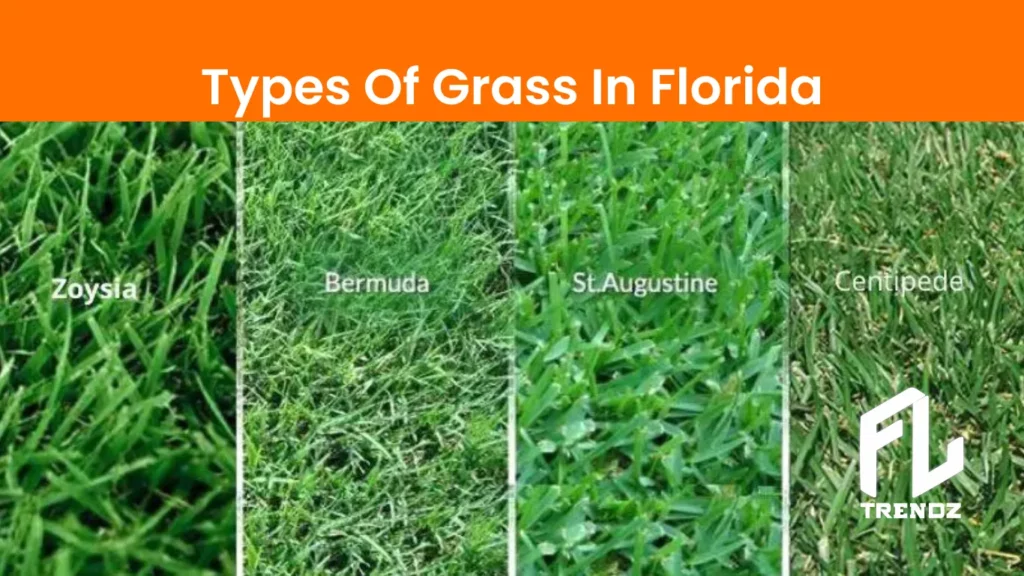Best Types of Grass in Florida: Top Picks for Your Lawn
A green environment is crucial for shielding species from the Sun’s harmful radiation. Homeowners of luxury properties in Florida often desire lush, green lawns to enhance the charm of their homes and promote well-being.
If you are new to selecting grass, understanding the different types of grass in Florida can be overwhelming.
This guide will explore the types of lawn grass in Florida to help you choose the best option. Let’s delve into these top grass types, covering everything from what type of grass grows in Florida to the varieties suitable for specific regions, including types of grass in South Florida, Central Florida, and North Florida.
Best Types of Grass in Florida

Florida’s diverse climate supports numerous types of grasses, both native and non-native. Understanding what type of grass is best for the southernmost villages in Florida or what works in other areas is key, especially with the impacts of climate change.
If you’re thinking about landscaping or lawn care as a business, understanding how to start a business in Florida can help you get set up legally and efficiently.
Below are the types of grass in Southwest Florida, as well as grasses that thrive across different parts of the state.
St. Augustine Grass
St. Augustine grass is widely used across the state, from North Florida to South Florida, thanks to its rapid growth and lush appearance. It’s commonly planted in warm regions and features deep roots, making it perfect for lawn coverage.
Key Factors
- Growth: 2-3 inches per month
- Ideal for residential and commercial landscaping
- Reduces soil erosion and flourishes in fertilized land
For those considering types of St. Augustine grass in Florida, here are the main varieties:
| Type | Uses | Growth/Month |
| Floratum | Residential lawns, landscaping | 2.5-3 inches |
| Raleigh | Popular for residential lawns | 2-2.5 inches |
| Seville | Ideal for coastal areas | 2-2.5 inches |
| Delta Shade | Best in shaded areas | 1.5-2 inches |
| Captiva | Erosion control landscaping | 2.5-3.5 inches |
Lawn care enthusiasts should be aware of property regulations, including plant laws and whether marijuana is legal in Florida, especially if growing unique vegetation.
Zoysia Grass
Known for its softness and dark green color, Zoysia grass is a fantastic choice for residential and commercial use. It is relatively low maintenance and can adapt to different types of grass weeds in Florida without much hassle.
Key Factors
- Growth: 1-2 inches per month
- Thrives in changing climates and requires less water
Looking into the types of Zoysia grass in Florida, here are some options:
| Type | Uses | Growth/Month |
| Empire | Residential and commercial | 1.5-2 inches |
| Emerald | Shade-tolerant areas | 1-1.5 inches |
| Meyer | Adaptable to various soils | 1-2 inches |
| Nitra | Fast-growing landscaping | 2-2.5 inches |
| Trinity | Low-maintenance lawns | 1-1.5 inches |
When landscaping, it’s useful to consider incorporating native plants, like the fruit trees Florida is known for, to enhance your lawn’s appeal and ecosystem.
Bermuda Grass
Commonly found on sports fields and lawns, Bermuda grass has a fine texture and vibrant color. It can handle Florida’s intense heat, making it a top choice among the types of grass in Central Florida and other regions.
Key Factors
- Heat-tolerant and resilient
- Growth: 2-3 inches per month
Varieties and Uses
| Type | Uses | Growth/Month |
| Tifway 419 | Sports fields and lawns | 2.5-3 inches |
| Tifsport | Ideal for high-traffic areas | 3-3.5 inches |
| Celebration | Residential lawns | 2-2.5 inches |
| Latitude 36 | Drought-tolerant landscaping | 2-2.5 inches |
| Black Beauty | Ornamental areas | 1.5-2 inches |
Knowing when hurricane season is in Florida is crucial for lawn maintenance, as grass and landscaping can be severely impacted by extreme weather.
Bahia Grass
Bahia grass, medium green in color, is ideal for Southwest Florida because of its adaptability and low maintenance. It thrives in sandy or clay soils and requires plenty of sunlight.
Key Factors
- Growth: 2-3 inches per month
- Performs well in full sunlight
Varieties and Uses
| Type | Uses | Growth/Month |
| Pensacola | Pasture and hay production | 2.5-3 inches |
| Tifton 9 | High-quality forage | 2.5-3 inches |
| Argentine | Lawns and landscaping | 2-2.5 inches |
| Cayman | Drought-tolerant landscaping | 1.5-2 inches |
| Oasis | High-yield pasture areas | 3-3.5 inches |
For those inspired by nature, the Florida Panhandle beaches are a reminder of how natural beauty, including grass and coastal vegetation, can enhance any landscape.
Centipede Grass
With a fine texture, Centipede grass is effective in reducing fungal infections. It is suitable for warm weather and is best for lawns in Florida.
Key Factors
- Minimal water requirements
- Native to Southeast America
- Growth: 1-2 inches per month
Varieties and Uses
| Type | Uses | Growth/Month |
| Oaklawn | Drought-tolerant lawns | 1-2 inches |
| TifBlair | Shade-tolerant landscaping | 1-2 inches |
| Centennial | High-traffic areas | 1.5-2 inches |
| Serala | Low-maintenance lawns | 0.5-1 inch |
| Hamel | Adaptable to various soils | 1-1.5 inches |
Bird lovers may want to choose grass types that support local wildlife, like Florida woodpeckers, adding a harmonious element to their outdoor space.
Seashore Paspalum
Used in sports fields and coastal landscaping, Seashore Paspalum thrives in salt-affected soils and minimal water conditions.
Key Factors
- Growth: 2-3 inches per month
- Full sunlight requirement
Varieties and Uses
| Type | Uses | Growth/Month |
| Seasle 2000 | Golf courses and coastal areas | 2-2.5 inches |
| Seasle Supreme | High-traffic sports fields | 2.5-3 inches |
| Aloha | Residential lawns | 1.5-2 inches |
| Passport | Erosion control landscaping | 2-2.5 inches |
| Ultimate | Salt-tolerant lawns | 2-2.5 inches |
Creating a lush lawn can attract beautiful blue birds in Florida, turning your outdoor area into a serene and lively habitat for wildlife.
Buffalo Grass
Native to North America, Buffalo grass is perfect for dry and sunny locations, often found in North Florida areas that require low water maintenance.
Key Factors
- Growth: 2-3 inches per month
- Soft texture and ecosystem support
Varieties and Uses
| Type | Uses | Growth/Month |
| Cody | Drought-tolerant areas | 2-2.5 inches |
| Prestige | High-traffic landscaping | 2.5-3 inches |
| Legacy | Erosion control | 1.5-2 inches |
| Turf | High-yield sports fields | 3-3.5 inches |
| Plains | Wildlife and habitat areas | 1-1.5 inches |
If you’re thinking about combining pool services with lawn care, learning how to start a pool cleaning business in Florida can diversify your offerings.
Conclusion
With Florida’s unique climate, selecting the right types of grass is crucial for a lush and healthy lawn. This guide provides an overview of the best options for 2024, tailored to specific needs across regions like Central Florida and South Florida. For more expert lawn tips, stay connected with our site.



Your article helped me a lot, is there any more related content? Thanks!
I don’t think the title of your article matches the content lol. Just kidding, mainly because I had some doubts after reading the article.
laua90
I don’t think the title of your article matches the content lol. Just kidding, mainly because I had some doubts after reading the article.
2bxud0
m7c81r
dvo9ba
0z4a3n
nbvh7t
GoGaB6ByXBx
V2TNNzz4uH0
mM65grW05zN
kork28TqTMv
IeyY7p48Gud
OBXf1jFiCWM
kWIe3WAONlZ
mhPJxlDjbXH
hOfq7qundq2
q1KqNLmeUXX
zhUnCnvtPBy
AXFct86A9iE
XYSQ66s2mcL
vKRl9rOTrGS
oYvluDiCg3k
DD9GdRtPOcY
5waA0yoAuXx
VJAeP3vtDCL
jBsL0MVFQIN
4naiVZOPcwS
bWGCYnZ5Q7g
m2D4gcwYPSd
23ygs11T3sC
gn6Pa6iXY50
mc0VTMfOXYv
tNcqjmkK87m
aVMmGifbWnp
0w9mDYQeXgt
7P4iN9cwLxV
6CcOdHcjFcK
NtCxVV48sAM
43eank46ppx
ylSRznOD9F5
rITSDYrjP5A
gPYuGimhn1u
LcpuTxL2JxS
I admire your dedication to providing useful content for your readers. Thanks for sharing your knowledge and expertise.
oj1437
I really like the way you articulate things; it’s obvious and concise.
I love how your distinctive character shines through in your words. It feels like we’re engaging in a meaningful conversation.
This post went beyond my expectations, thank you.
qxubkp
nshca9
zlxzxo
ffahc6
spm7bm
cfhc41
hg05t9
8s6f7v
67swbm
fngt61
Your point of view caught my eye and was very interesting. Thanks. I have a question for you. https://accounts.binance.info/sl/register?ref=PORL8W0Z
pd8m61
kpveqv
7d7xlw
h92027
gkbcpb
szeder
gfx4b9